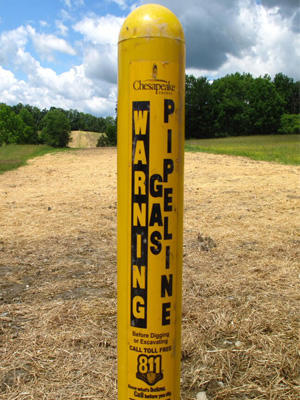Pipeline Safety Education
Gas Emergencies
If you smell gas while indoors
- If indoors, leave your home/building immediately!
- Do NOT turn on or off lights
- Do NOT make calls from a land line or cell phone while inside.
- Do NOT cause a spark.
- Leave windows and doors open while exiting to allow gas to vent outside.
2. Call 911 and your utility (if you know the number) from a safe distance away from the odor.
3. Utility company personnel will be dispatched.
5. Wait for the Utility Company personnel or emergency services personnel to tell you it's safe to return to your home/building.
If you smell gas while outside
- If outdoors, move away from the area.
- Call 911 and the utility (if you know the number) from a safe distance, away from the odor.
- Utility company personnel will be dispatched.
- Wait for the Utility Company personnel or emergency services personnel to tell you it's safe.
Pipeline Markers
Many buried pipelines used in the transportation of natural gas are identified by above ground pipeline markers. Pipeline markers are located along certain pipeline routes that identify the approximate location of the pipeline.
Every pipeline marker provides critical information to the general public and emergency responders such as the company that operates the pipeline, product transported, and a phone number that should be called in the event of an emergency. Below you can see examples of pipeline markers.




Preparedness Requirements
To comply with Federal regulations, operators must conduct periodic Pipeline Awareness Program (PAP) effectiveness evaluations no more than four years apart, following the date of program implementation. The requirement includes lines maintained by an operator that could go back into service. You can view the federal regulations here.
A PAP inspection includes a written PAP and records such as stakeholder lists, brochures, or pamphlets indicating message, documentation of sent messages, maps, procedures, plans, evaluation results, follow-up actions, and other relevant documentation that supports compliance. Operators must maintain records of key program documentation to demonstrate compliance with the public awareness regulations. Under §192.616(c) and §195.440(c), each operator must follow the general program recommendations which include retaining records for each category listed in API RP 1162 Section 7.2 for a minimum of five (5) years, or as defined in the operator’s PAP, whichever is longer.
Pipeline Safety Awareness Programs
The Pipeline Safety Program not only inspects gas pipelines and infrastructure, it also oversees gas pipeline operator’s pipeline safety awareness programs.
Each operator has a responsibility to follow the Pipeline and Hazardous Material Safety Administration’s (PHMSA’s) Federal pipeline safety regulations requiring pipeline operators to conduct public awareness programs to provide pipeline safety information to four stakeholder audiences, including:
- Affected public
- Emergency officials,
- Local public officials, and
- Excavators
Awareness programs are based on guidance provided by the American Petroleum Institute (API) Recommended Practice (RP) 1162, Public Awareness Programs for Pipeline Operators. You can learn more about the API guidance at this link.
Roles During an Emergency
Colorado’s Pipeline Safety Program (PSP) does not have an active role in responding to pipeline emergencies though in some cases the PSP will be responsible for investigating the failure and will be on-site after an emergency for that reason. Local emergency departments generally take the lead with support from operators. Colorado’s Energy and Carbon Management Commission will assist with clean up. Federal agencies will get involved only in certain instances – such as a large incident may cause the Environmental Protection Agency (link) to help with remediation or the National Transportation Safety Board (link) may choose to investigate.
Partners
The Pipeline Safety Program partners with numerous agencies and organizations including the Energy & Carbon Management Commission, Colorado Department of Public Health and Environment, Colorado 811, Pipeline and Hazardous Materials Safety Administration (PHYMSA), NPS, Pipeline Association for Public Awareness, Pipeline Safety Trust, National Association of Pipeline Safety Representatives (NAPSR), National Transportation Safety Board and the Department of Energy’s Federal Energy Regulatory Commission.